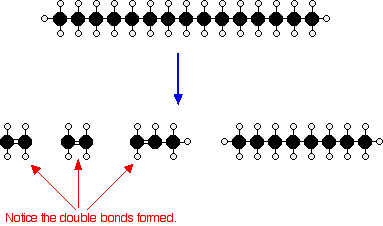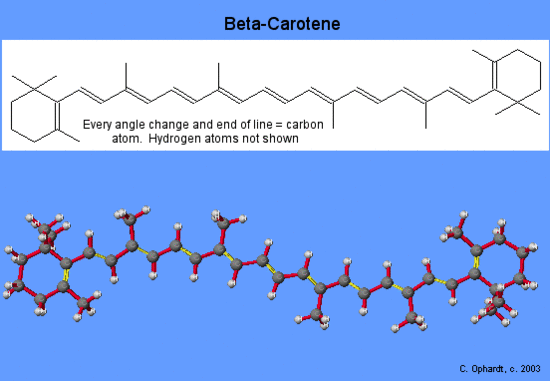Ethene
Cracking is the name given to breaking up large hydrocarbon molecules into smaller and more useful bits. This is achieved by using high pressures and temperatures without a catalyst, or lower temperatures and pressures in the presence of a catalyst. The source of the large hydrocarbon molecules is often the naphtha fraction or the gas oil fraction from the fractional distillation of crude oil (petroleum). These fractions are obtained from the distillation process as liquids, but are re-vaporized before cracking.
There is not any single unique reaction happening in the cracker. The hydrocarbon molecules are broken up in a fairly random way to produce mixtures of smaller hydrocarbons, some of which have carbon-carbon double bonds. One possible reaction involving the hydrocarbon C15H32 might be:

Or, showing more clearly what happens to the various atoms and bonds:

This is only one way in which this particular molecule might break up. The ethene and propene are important materials for making plastics or producing other organic chemicals. You will remember that during the polymeriation of ethene, thousands of ethene molecules join together to make poly(ethene) - commonly called polythene. The reaction is done at high pressures in the presence of a trace of oxygen as an initiator.

Beta-Carotene
The long chain of alternating double bonds (conjugated) is responsible for the orange color of beta-carotene. The conjugated chain in carotenoids means that they absorb in the visible region - green/blue part of the spectrum. So β-carotene appears orange, because the red/yellow colors are reflected back to us.

Vitamin A
Vitamin A has several functions in the body. The most well known is its role in vision - hence carrots "make you able to see in the dark". The retinol is oxidized to its aldehyde, retinal, which complexes with a molecule in the eye called opsin. When a photon of light hits the complex, the retinal changes from the 11-cis form to the all-trans form, initiating a chain of events which results in the transmission of an impulse up the optic nerve. A more detailed explanation is in Photochemical Events.

Other roles of vitamin A are much less well understood. It is known to be involved in the synthesis of certain glycoproteins, and that deficiency leads to abnormal bone development, disorders of the reproductive system, xerophthalmia (a drying condition of the cornea of the eye) and ultimately death.
Vitamin A is required for healthy skin and mucus membranes, and for night vision. Its absence from diet leads to a loss in weight and failure of growth in young animals, to the eye diseases; xerophthalmia, and night blindness, and to a general susceptibility to infections. It is thought to help prevent the development of cancer. Good sources of carotene, such as green vegetables are good potential sources of vitamin A. Vitamin A is also synthetically manufactured by extraction from fish-liver oil and by synthesis from beta-ionone.





